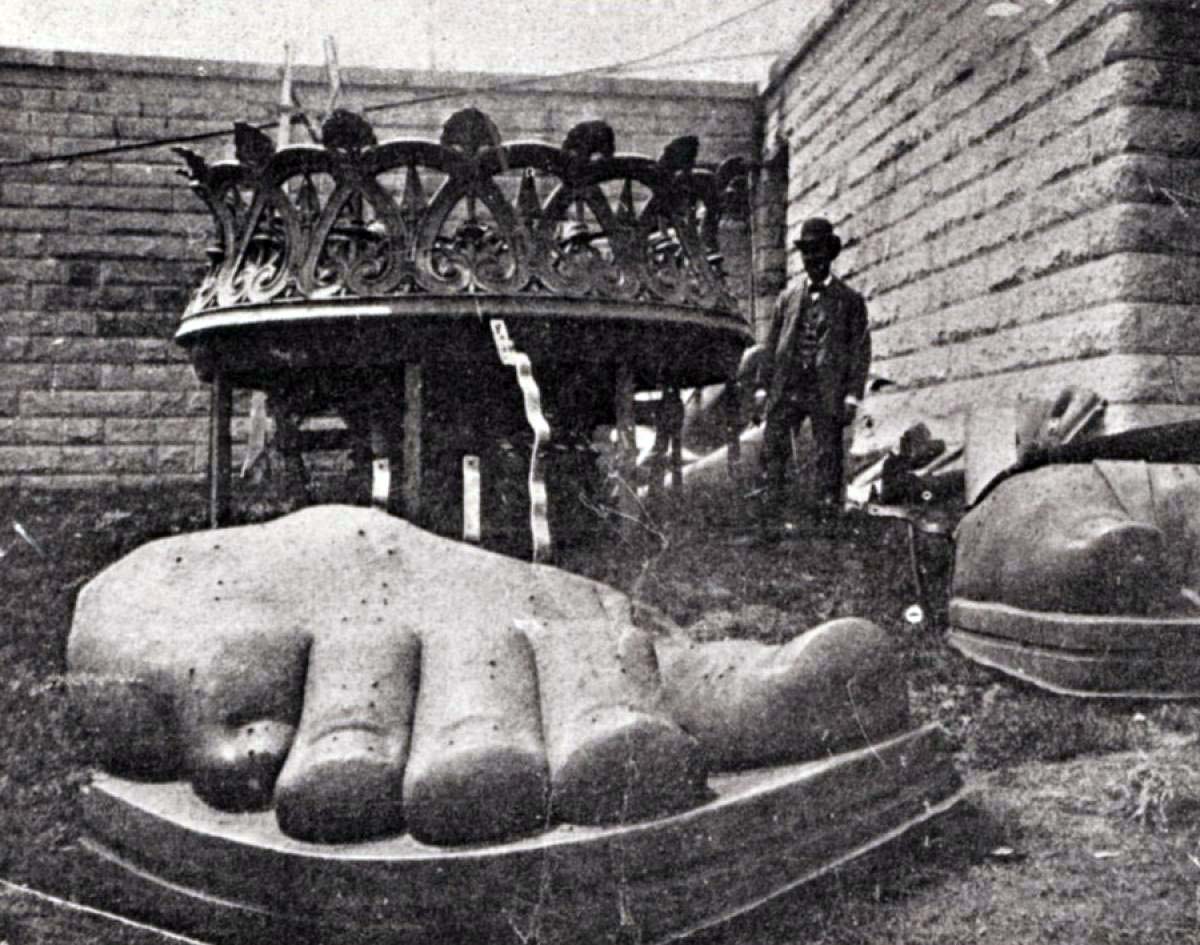Imagine the sheer scale of thousands of people coming together to design, construct and transport the Statue of Liberty all the way from France on a ship called Isére, to New York. It’s quite an astonishing feat, even if it was a decade overdue. Now, imagine all of that work had been successfully completed, only for the 350 iron pieces of Lady Liberty to sit unassembled on an East Coast dock for more than one year until the birth of crowdfunding! Let’s dive in…

The feet of the Statue of Liberty after arriving in New York
Why did this happen?
The US had failed to raise all of the $250,000 ($6.15m in 2018 terms) necessary to purchase a huge granite base for the Lady in the Harbor. The fundraising committee fell around $100,000 ($2.4m today) short, NY Governor Grover Cleveland refused to use city funds, and Congress could not agree on a funding package either. Cities across the US, like San Francisco and Philadelphia, were among many opportunists who offered to pay for the granite base in exchange for the statue!
In 1885, the project was verging on failure, so with defeat looming and New York struggling to find a solution, famous publisher Joseph Pulitzer arrived on the scene to save the day.
Pulitzer launched a fundraising campaign in his newspaper, The New York World. He famously printed the words:
“Let us not wait for the millionaires to give us this money. It is not a gift from the millionaires of France to the millionaires of America, but a gift of the whole people of France to the whole people of America.”
And thus, Crowdfunding was born.
What were the stats of Liberty?
- More than 160,000 donors contributed a total of $101,091
- The average donation was $0.61
- 75% of donations were less than $1.00
- Over 200,00 New Yorkers lined up to see the unveiling
- 225 tonnes, the weight of Lady Liberty
Statue of Liberty, 1900
Who paid for the statue itself?
On the other side of the pond, French politician and abolitionist Édouard René de Laboulaye not only inspired the idea of the Statue of Liberty to Frédéric Bartholdi (the artist and designer) but also went about his own mission of securing funding to realize the project. Laboulaye and Bartholdi cut a deal with their American counterparts, agreeing that if the US paid for the base of the statue, and secured the rights to Bedloe’s Island (now Liberty Island), then they would fund the statue in return.
Unlike Pulitzer’s crowdfunding approach, Laboulaye (who had now been promoted to a senator) opted for a more traditional route, asking wealthy friends and colleagues to support the build. Regional government, school owners, mine owners and businessmen were more than happy to contribute towards the symbol of liberty after the fall of Napoleon III. Laboulaye managed to raise around ₣250,000 ($5.7m equivalent in 2018) by going directly to the wealthy and asking for money, and in some ways, you could argue he was equally successful. However, by taking the money directly from the wealthy, it actually made Pulitzer’s ‘This is not a gift from the millionaires of France’ quote a bit untrue.
The birth of crowdfunding
In modern-day terms, websites like Kickstarter, Indiegogo, StartEngine and SeedInvest to name a few, facilitate the crowdfunding process for anyone who has an idea and the time to set up a page. The basis of these websites is very similar to what Pulitzer achieved in 1885; it used a single point of donation for a large group of potential donors and appealed for any amount towards the end goal.
The most successful crowdfunding campaigns in current times all share the same common traits: they offer a solution to many people or a luxury to few, they will naturally gain media coverage due to their interesting nature, and they inspire faith in backers through transparency and updates.
How would we know what a successful crowdfunding campaign looks like?
Well, we’ve done several, so you could say that we are getting pretty good at it now.
There’s a difference between Kickstarter and the type of crowdfunding that we have successfully engaged in. With Kickstarter, the idea is to bring creative ideas to the real world, whereas we launched an equity crowdfunding campaign, which is designed to give a huge boost to projects that already have strong traction. In 2016, we raised $6.1m in indicated interest (more than the cost of building the Statue of Liberty!).
Who supported our campaign?
By looking at industry statistics, 47% of millennials have backed crowdfunding of some kind, whereas it’s only 30% of Gen-Xers and 13% of baby boomers. Millennials believe in community support, creativity, and innovative tools for the future, which is why 85% of this generation state that their investment decisions are heavily swayed by social and environmental impacts.
An EV sports car like the Tomahawk was the perfect concept for an equity crowdfunding campaign, blending style, innovation, cryptocurrency, future-tech, alternative energies and community into one four-wheeled beauty!

/cdn.vox-cdn.com/uploads/chorus_image/image/47906097/MNY228567-thumb.0.jpg)